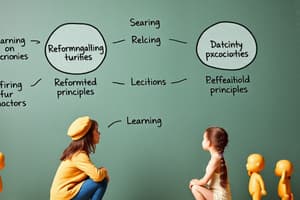Podcast
Questions and Answers
What is the primary goal of the onboarding process according to the content?
What is the primary goal of the onboarding process according to the content?
- To ensure all employees are the same
- To help employees fit into the company's mold
- To maintain status quo within the company
- To allow employees to express their unique skills and perspectives (correct)
Which phase of the ADDIE model involves gathering and analyzing data to determine learning and development needs?
Which phase of the ADDIE model involves gathering and analyzing data to determine learning and development needs?
- Evaluation
- Implementation
- Analysis (correct)
- Design
What approach should be taken to increase the effectiveness of onboarding training according to the content?
What approach should be taken to increase the effectiveness of onboarding training according to the content?
- Limiting interactions to online platforms
- Providing rigid and defined roles for new hires
- Focusing on theoretical knowledge only
- Encouraging a safe environment for experimentation (correct)
What misconception about onboarding is addressed in the content?
What misconception about onboarding is addressed in the content?
Who plays a critical role in maximizing the effectiveness of training programs?
Who plays a critical role in maximizing the effectiveness of training programs?
What is an example of a metric used to evaluate the results of training according to Kirkpatrick's evaluation framework?
What is an example of a metric used to evaluate the results of training according to Kirkpatrick's evaluation framework?
What should managers do several months after training to support ongoing learning?
What should managers do several months after training to support ongoing learning?
What is a recommended action during training to enhance trainee learning?
What is a recommended action during training to enhance trainee learning?
Before training begins, what is a key responsibility of managers towards employees?
Before training begins, what is a key responsibility of managers towards employees?
Which aspect of trainee reactions is assessed through satisfaction surveys?
Which aspect of trainee reactions is assessed through satisfaction surveys?
What is a primary focus of behaviorism in the learning process?
What is a primary focus of behaviorism in the learning process?
Which component of the ADDIE model comes first?
Which component of the ADDIE model comes first?
Which learning theory emphasizes the change in mental schema through information organization?
Which learning theory emphasizes the change in mental schema through information organization?
What is considered a major outcome of effective onboarding processes?
What is considered a major outcome of effective onboarding processes?
In experiential learning, what is emphasized as crucial for gaining new skills?
In experiential learning, what is emphasized as crucial for gaining new skills?
What is one of the key principles applied in effective training and development?
What is one of the key principles applied in effective training and development?
What does socialization in the onboarding process primarily focus on?
What does socialization in the onboarding process primarily focus on?
Which learning style encourages reflection and experimentation as core components?
Which learning style encourages reflection and experimentation as core components?
What percentage of a trainee's learning is typically lost within a year after training?
What percentage of a trainee's learning is typically lost within a year after training?
Which of the following is NOT a part of the information provided during effective onboarding?
Which of the following is NOT a part of the information provided during effective onboarding?
Which factor is NOT mentioned as critical for encouraging the transfer of training?
Which factor is NOT mentioned as critical for encouraging the transfer of training?
What is a critical component of effective onboarding relationships?
What is a critical component of effective onboarding relationships?
Which of the following statements best describes the importance of feedback after training?
Which of the following statements best describes the importance of feedback after training?
Which component is part of Kirkpatrick’s Level 3 Evaluation?
Which component is part of Kirkpatrick’s Level 3 Evaluation?
What is the primary purpose of after-action reviews (AARs)?
What is the primary purpose of after-action reviews (AARs)?
What can hinder the transfer of training most significantly?
What can hinder the transfer of training most significantly?
Which is NOT a suggested support method after training?
Which is NOT a suggested support method after training?
Which level of Kirkpatrick’s model focuses on trainee reactions to training?
Which level of Kirkpatrick’s model focuses on trainee reactions to training?
What should be emphasized as a new employee approaches the 6-month mark?
What should be emphasized as a new employee approaches the 6-month mark?
In addition to job performance, what other factor should onboarding activities focus on?
In addition to job performance, what other factor should onboarding activities focus on?
What is a key action to take before an employee's first day?
What is a key action to take before an employee's first day?
What role do supportive managers play in a new hire's onboarding?
What role do supportive managers play in a new hire's onboarding?
What is a disadvantage of relying solely on technological support systems for onboarding?
What is a disadvantage of relying solely on technological support systems for onboarding?
What should be prioritized during the first three months of a new employee's onboarding?
What should be prioritized during the first three months of a new employee's onboarding?
How can peer mentors assist new employees during onboarding?
How can peer mentors assist new employees during onboarding?
What is one important element of cohort orientations?
What is one important element of cohort orientations?
Which aspect should be integrated into onboarding strategies to align with an organization’s values?
Which aspect should be integrated into onboarding strategies to align with an organization’s values?
What should managers consistently provide to new employees during the onboarding period?
What should managers consistently provide to new employees during the onboarding period?
Flashcards are hidden until you start studying
Study Notes
Learning & Development
- Learning and development are initiatives taken to improve knowledge, skills, and abilities within an organization.
- These initiatives can be formal or informal and take place at various points in an employee's journey.
- Onboarding is a type of learning and development that happens at the start of employment.
- Learning and development help attract and retain talent, achieve business results, and remain competitive.
Learning Theories
- Cognitivism focuses on the mind and how information is received, organized, stored, and retrieved.
- Behaviorism focuses on learning through rewards and punishments, leading to behavioral change.
- Experiential learning emphasizes learning from experience, reflection, and experimentation.
Onboarding
- Onboarding is the process of helping new hires adapt to their roles and the organization.
- Socialization is the process of becoming an "insider" within an organization.
- Effective onboarding provides new hires with crucial information, including organization basics, job-specific details, and a sense of organizational identity.
- Building relationships is a key aspect of onboarding, fostering a sense of belonging and creating avenues for information sharing.
- Managers play a crucial role in onboarding by providing initial information, meeting frequently, and fostering proactivity in new hires.
Training
- Training programs focus on developing knowledge and skills for specific job roles.
- Orientation programs typically occur on or near a new employee's start date and are often formal and well-organized.
- Technological support systems can be helpful for disseminating information, but may lack the social elements needed for successful onboarding.
- Cohort orientations offer opportunities for relationship building.
- Peer mentors provide a safe space for new hires to ask questions and learn the ropes.
Training Effectiveness
- The ADDIE model, a structured instructional design approach, guides organizations in creating effective learning and development programs.
- The ADDIE model consists of five phases: Analysis, Design, Development, Implementation, and Evaluation.
- Analysis involves determining what skills are needed and who requires training.
- The Kirkpatrick training evaluation model provides a structured approach to evaluate training effectiveness.
- Encouraging transfer of training through support, practice, and performance feedback are crucial for success.
- Communities of practice (CoPs) can facilitate knowledge sharing and expertise development.
Trends in Learning & Development
- Digital learning is becoming increasingly prevalent.
Manager's Role in Learning & Development
- Managers are responsible for providing guidance, support, and opportunities for employees to connect and integrate.
- Managers can help identify training needs, guide employees to appropriate training programs, and support their learning after training.
- Managers play a significant role in fostering a learning climate within the organization.
Studying That Suits You
Use AI to generate personalized quizzes and flashcards to suit your learning preferences.




